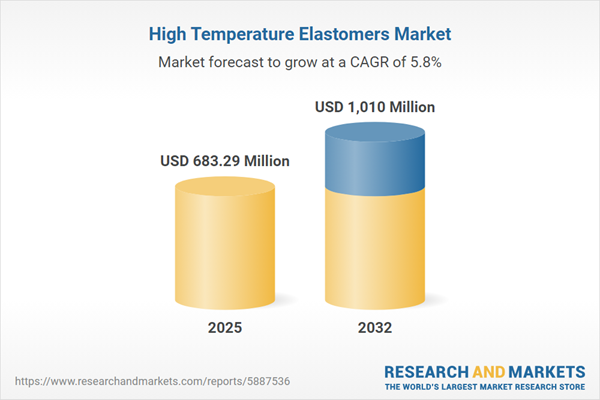Speak directly to the analyst to clarify any post sales queries you may have.
Senior decision-makers in the high temperature elastomers market are contending with technology shifts, tightening regulations, and evolving procurement priorities. This concise research overview delivers the market intelligence needed to inform strategic direction and strengthen operational resilience in a dynamic global landscape.
Market Snapshot: High Temperature Elastomers Market Growth Drivers
The high temperature elastomers market is expected to expand, valued at USD 645.08 million in 2024 and projected to reach USD 683.29 million by 2025, advancing at a 5.79% CAGR. This momentum is underpinned by advancements in material science that have significantly improved product durability and reliability for engineering and industrial settings. Industries are also leveraging smart manufacturing to streamline processes, boosting efficiency through automation. As sustainability becomes integral, companies increasingly shift toward eco-conscious sourcing and more stringent environmental standards. High temperature elastomers now play a core role in sectors where stringent operational reliability is essential, from advanced automotive systems to sophisticated electrical insulation.
Scope & Segmentation: Strategic Market Intelligence for Decision Makers
To equip leaders with actionable insight, this report segments the high temperature elastomers market across all dimensions influencing competitive advantage and regulatory alignment. Each category is chosen for direct relevance to strategic planning, resource optimization, and positioning as industry paradigms shift.
- Elastomer Types: Acrylic elastomer, ethylene acrylic rubber, fluoroelastomers, perfluoroelastomer, high consistency silicone elastomers, and liquid silicone elastomers are assessed for their roles in achieving stable high-temperature performance.
- Applications: Coverage includes automotive hoses, O-rings, seals, gaskets, valve packing, and electrical insulation, targeting key sectors where reliability and compliance drive procurement decisions.
- End-Use Industries: Analysis spans aerospace and defense, commercial vehicles, passenger vehicles, electrical systems, industrial production, oil and gas, and pharmaceuticals, reflecting the sector’s wide-ranging compliance environments.
- Product Forms: The study evaluates films, liquids, and solids to ensure manufacturers address varied processing and production requirements efficiently.
- Processing Technologies: The report investigates calendering, extrusion, and molding technologies and their importance in scalable, innovative manufacturing processes.
- Geographies: Evaluation covers the Americas, EMEA, and Asia-Pacific, offering localized insight for compliance, customer needs, and technology leadership.
- Company Coverage: Profiles include DuPont de Nemours, Solvay, 3M, Daikin Industries, Parker-Hannifin, Freudenberg, Saint-Gobain, Trelleborg, Zeon, and JSR Corporation to illustrate best practices in supply assurance and innovation.
Key Takeaways for Senior Decision-Makers
- Material and engineering improvements broaden industry use, positioning elastomers for evolving technical demands in areas such as aerospace, advanced manufacturing, and heavy industry.
- Developing supply chain partnerships and collaborative relationships accelerates the creation of custom solutions, helping organizations streamline both market entry and new product development cycles.
- Sustainability now plays a decisive role in procurement, with growing emphasis on bio-based feedstocks and closed-loop recycling to meet evolving ethical and supply chain requirements.
- Advanced manufacturing tools—including real-time process monitoring and predictive analytics—greatly enhance quality controls and drive traceability.
- Regional priorities shape growth strategies: the Americas frequently lead technological innovation, EMEA emphasizes regulatory alignment, and Asia-Pacific focuses on manufacturing scale and process automation.
- Building corporate agility through deep technical expertise and reliable supply partnerships is essential to respond to industry transformation and manage risk mitigation.
Tariff Impact: Navigating US Tariffs and Supply Chain Realignment
Planned US tariffs for 2025 are driving organizations to adapt their sourcing and procurement frameworks. Leading suppliers are emphasizing local and regional collaboration to buffer against international disruptions. This realignment underpins greater market stability and supports continuity of operations in a shifting trade scenario.
Methodology & Data Sources
Research insights in this report are based on executive-level interviews, in-depth workshops, comprehensive regulatory analysis, and global patent reviews. Scenario modeling and peer-reviewed studies further ensure conclusions are actionable and specifically shaped to support executive strategy.
Why This Report Matters
- Delivers focused market intelligence to reinforce supply chain robustness and support sustainable procurement strategies.
- Arms decision-makers with segmentation insights vital for addressing regulatory risk and adapting to policy changes.
- Guides operational planning for performance, fostering process efficiency and compliance with evolving industry standards.
Conclusion
Senior leaders will find actionable guidance to navigate disruption, accelerate resilience, and drive forward-looking initiatives in the high temperature elastomers market. This report serves as a trusted tool to inform decision-making amid ongoing industry transformation.
Additional Product Information:
- Purchase of this report includes 1 year online access with quarterly updates.
- This report can be updated on request. Please contact our Customer Experience team using the Ask a Question widget on our website.
Table of Contents
3. Executive Summary
4. Market Overview
7. Cumulative Impact of Artificial Intelligence 2025
Companies Mentioned
The companies profiled in this High Temperature Elastomers market report include:- DuPont de Nemours, Inc.
- Solvay SA
- 3M Company
- Daikin Industries, Ltd.
- Parker-Hannifin Corporation
- Freudenberg SE
- Saint-Gobain S.A.
- Trelleborg AB
- Zeon Corporation
- JSR Corporation
Table Information
| Report Attribute | Details |
|---|---|
| No. of Pages | 180 |
| Published | November 2025 |
| Forecast Period | 2025 - 2032 |
| Estimated Market Value ( USD | $ 683.29 Million |
| Forecasted Market Value ( USD | $ 1010 Million |
| Compound Annual Growth Rate | 5.7% |
| Regions Covered | Global |
| No. of Companies Mentioned | 11 |









